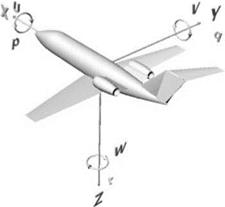Flow Past Aerofoil
A typical airflow past an aerofoil is shown in Figure 3.6; it is an extension of the diagram of flow over a flat plate (see Figure 3.4). In Figure 3.7, the front curvature of the aerofoil causes the flow to accelerate, with the associated drop in pressure, until it reaches the point of inflection on the upper surface of the aerofoil. This is known as a region of favorable pressure gradient because the lower pressure downstream favors airflow. Past the inflection point, airflow starts to decelerate, recovering the pressure (i. e., flow in an adverse pressure gradient) that was lost while accelerating. For inviscid flow, it would reach the trailing edge, regaining the original free streamflow velocity and pressure condition. In reality, the viscous effect depletes flow energy, preventing it from regaining the original level of pressure. Along the aerofoil surface, airflow is depleting its energy due to friction (i. e., the viscous effect) of the aerofoil surface.
The result of a loss of energy while flowing past the aerofoil surface is apparent in adverse pressure gradient – it is like climbing uphill. A point may be reached where there is not enough flow energy left to encounter the adverse nature of the downstream pressure rise – the flow then leaves the surface to adjust to what nature allows. Where the flow leaves the surface is called the point of separation, and it is critical information for aircraft design. When separation happens over a large part of the aerofoil, it is said that the aerofoil has stalled because it has lost the intended pressure field. Generally, it happens on the upper surface; in a stalled condition, there is a loss of low-pressure distribution and, therefore, a loss of lift, as described in Section 3.6. This is an undesirable situation for an aircraft in flight. There is a minimum speed below which stalling will occur in every winged aircraft. The speed at which an aircraft stalls is known as the stalling speed, Vstall. At stall, an aircraft cannot maintain altitude and can even become dangerous to fly; obviously, stalling should be avoided.
For a typical surface finish, the magnitude of skin-friction drag depends on the nature of the airflow. Below Recrit, laminar flow has a lower skin friction coefficient, Cf, and, therefore, a lower friction (i. e., lower drag). The aerofoil LE starts with a low Re and rapidly reaches Recrit to become turbulent. Aerofoil designers must shape the aerofoil LE to maintain laminar flow as much as possible.
Aircraft surface contamination is an inescapable operational problem that degrades surface smoothness, making it more difficult to maintain laminar flow. As a result, Recrit advances closer to the LE. For high-subsonic flight speed (high Re), the laminar flow region is so small that flow is considered fully turbulent.
This section points out that designers should maintain laminar flow as much as possible over the wetted surface, especially at the wing LE. As mentioned previously, gliders – which operate at a lower Re – offer a better possibility to deploy an aerofoil with laminar-flow characteristics. The low annual utilization in private usage favors the use of composite material, which provides the finest surface finish. However, although the commercial transport wing may show the promise of partial
Figure 3.8. Six degrees of freedom in body axes FB
 laminar flow at the LE, the reality of an operational environment at high utilization does not guarantee adherence to the laminar flow. For safety reasons, it would be appropriate for the governmental certifying agencies to examine conservatively the benefits of partial laminar flow. This book considers the fully turbulent flow to start from the LE of any surface of a high-subsonic aircraft.
laminar flow at the LE, the reality of an operational environment at high utilization does not guarantee adherence to the laminar flow. For safety reasons, it would be appropriate for the governmental certifying agencies to examine conservatively the benefits of partial laminar flow. This book considers the fully turbulent flow to start from the LE of any surface of a high-subsonic aircraft.














